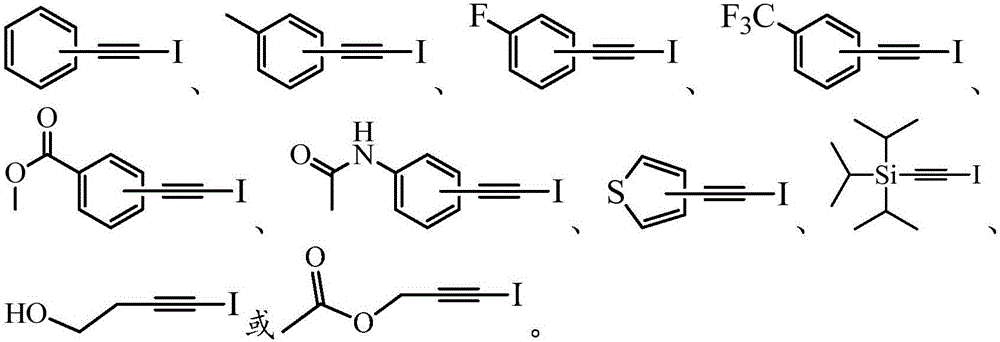Method for synthesizing 1-iodo-alkyne in high-selectivity manner
A highly selective, iodo-based technology, applied in organic chemistry methods, chemical instruments and methods, and the preparation of organic compounds, can solve the problems of using metal catalysts, harsh reaction conditions, uncontrollable reactions, etc. The effect of mild conditions and easy separation and purification
- Summary
- Abstract
- Description
- Claims
- Application Information
AI Technical Summary
Problems solved by technology
Method used
Image
Examples
Embodiment 1
[0032]
[0033] Dissolve 38 μL (0.3 mmol) of p-methylphenylacetylene and 133 mg (0.36 mmol) of tetrabutylammonium iodide (TBAI) in 3 mL of acetonitrile, then add 96.6 mg (0.3 mmol) of iodobenzenediacetic acid in portions within 30 min into the reaction system, react at room temperature for 24 h, and then extract three times with ethyl acetate, combine the organic phases and concentrate under reduced pressure to obtain the crude product 1. The crude product 1 was separated and purified by silica gel column chromatography (n-hexane 100%) to obtain 71.9 mg of yellow liquid product 1 with a yield of 99%. The NMR data are as follows:
[0034] ( 1 H NMR, 400MHz, CDCl 3 , ppm): δ=7.32(d, J=8.0Hz, 2H), 7.10(d, J=8.0Hz, 2H), 2.34(s, 3H);
[0035] ( 13 C NMR, 100MHz, CDCl 3 , ppm): δ=139.1, 132.3, 129.0, 120.4, 94.3, 21.6.
Embodiment 2
[0037]
[0038] 33 μL (0.3 mmol) of phenylacetylene and 133 mg (0.36 mmol) of tetrabutylammonium iodide were dissolved in 3 mL of acetonitrile, and then 96.6 mg (0.3 mmol) of iodobenzenediacetic acid was added to the reaction system in batches within 30 min. After reacting at room temperature for 24 h, and then extracting three times with ethyl acetate, the organic phases were combined and concentrated under reduced pressure to obtain the crude product 2. The crude product 2 was separated and purified by silica gel column chromatography (n-hexane 100%) to obtain 62.6 mg of yellow liquid product 2 with a yield of 92%. The NMR data are as follows:
[0039] 1 H NMR (400MHz, CDCl 3 ,ppm): δ=7.41-7.43(m,2H),7.29-7.31(m,3H);
[0040] 13 C NMR (100 MHz, CDCl3, ppm): δ = 132.4, 128.8, 128.3, 123.4, 94.2, 6.2.
Embodiment 3
[0042]
[0043] Dissolve 34.4 μL (0.3 mmol) of 4-fluorophenylacetylene and 133 mg (0.36 mmol) of tetrabutylammonium iodide in 3 mL of acetonitrile, then add 193.3 mg (0.6 mmol) of iodobenzenediacetic acid to the reaction in batches within 30 min In the system, react at room temperature for 2 h, and then extract three times with ethyl acetate, combine the organic phases and concentrate under reduced pressure to obtain the crude product 3. The crude product 3 was separated and purified by silica gel column chromatography (n-hexane 100%) to obtain 67.8 mg of yellow liquid product 3 with a yield of 92%. The NMR data are as follows:
[0044] 1 H NMR (400MHz, CDCl 3 , ppm): δ=7.42-7.40(m, 2H), 7.01(t, J=8.8Hz, 2H);
[0045] 13 C NMR (100MHz, CDCl 3 , ppm): δ=162.7 (d, J=249Hz), 134.3 (d, J=8.4Hz), 119.5 (d, J=3.5Hz), 115.7 (d, J=22.1Hz), 93.0, 5.9.
PUM
 Login to View More
Login to View More Abstract
Description
Claims
Application Information
 Login to View More
Login to View More - R&D
- Intellectual Property
- Life Sciences
- Materials
- Tech Scout
- Unparalleled Data Quality
- Higher Quality Content
- 60% Fewer Hallucinations
Browse by: Latest US Patents, China's latest patents, Technical Efficacy Thesaurus, Application Domain, Technology Topic, Popular Technical Reports.
© 2025 PatSnap. All rights reserved.Legal|Privacy policy|Modern Slavery Act Transparency Statement|Sitemap|About US| Contact US: help@patsnap.com



